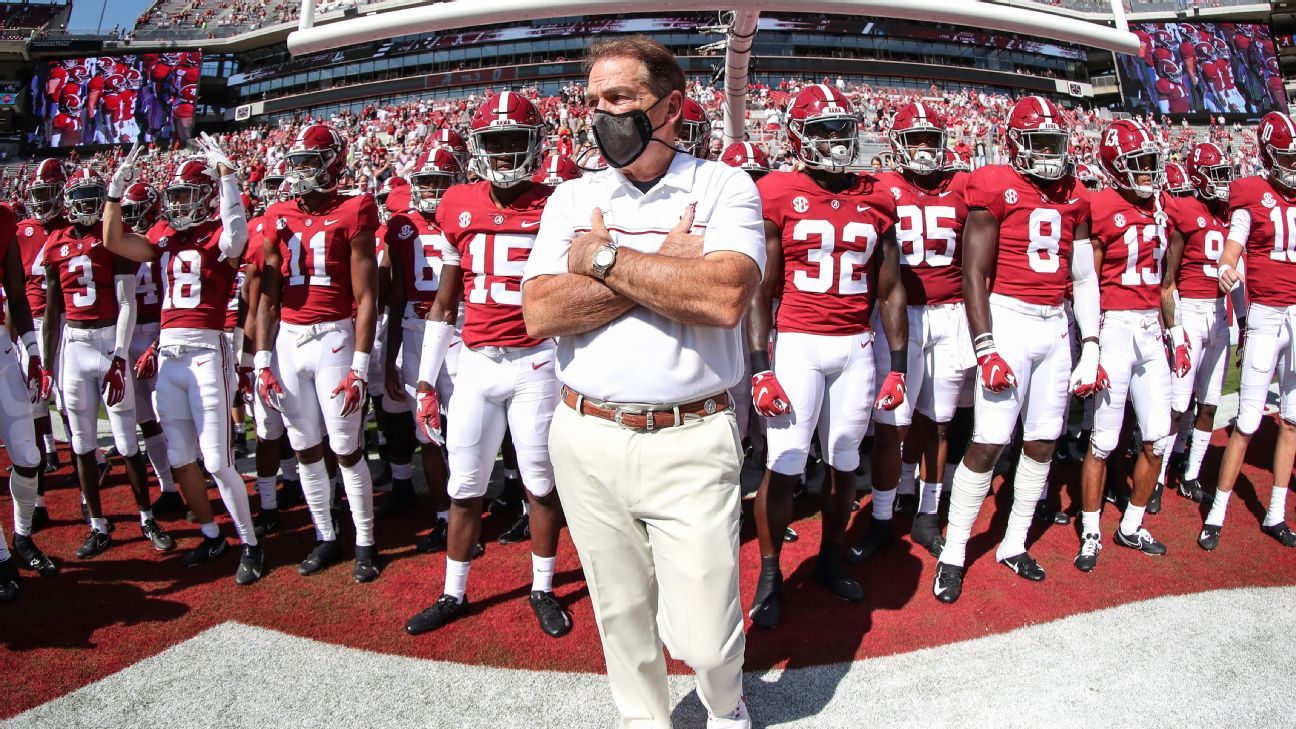After three relatively smooth weeks of SEC competition, COVID-19 caught up with the nation’s highest-profile conference within a span of three days.
The SEC postponed its first game Monday, as Vanderbilt, which had only 56 scholarship players available in last week’s 41-7 loss to South Carolina, could not safely play its next contest at Missouri. Tuesday brought reports of a significant COVID-19 outbreak at Florida, just days after coach Dan Mullen had implored university administrators to “Pack the Swamp” this week against LSU.
The Swamp will be empty after the SEC on Wednesday postponed the LSU-Florida game. Florida athletic director Scott Stricklin soon revealed 21 positive tests among players. Then, hours later, Alabama announced that coach Nick Saban and athletic director Greg Byrne both had tested positive for the virus. Ole Miss coach Lane Kiffin, whose team hosted Alabama last week, also hinted Wednesday about a spike in cases within his team, although Saturday’s game at Arkansas remains on track.
“Obviously,” Tennessee coach Jeremy Pruitt told reporters, “it has been a tough day.”
Those tough 72 hours once again raise questions about the season’s viability in the midst of a pandemic. Will college football get to the finish line? How many outbreaks and postponements are tolerable? What will the continued positive tests within the SEC indicate about game travel, testing, and the role of coaches, who are starting to contract the virus at a higher frequency?
Athletic administrators across the country who spoke to ESPN on Wednesday and Thursday aren’t panicking. While not dismissing the SEC’s problems, they say they expected game postponements and positive tests for notable coaches and players, and pointed to an entire offseason spent planning and revamping schedules to add flexibility for when disruptions occur. They continue to monitor virus data and trends, but have had no conversations about stopping the season.
“We all have invested a great deal of time and energy, the student-athletes have invested a great deal,” Arkansas AD Hunter Yurachek said. “I think this was expected. Our SEC medical task force told us there was going to be another spike in mid-to-late October, and I think that’s what we’re all seeing right now. That’s why we built in the make-up dates at the end of the season, because we thought something like this may occur, where we were going to lose some games during the season.”
Clemson athletic director Dan Radakovich said circumstances now are far different than they were in the spring, when college athletics essentially came to a screeching halt with one positive test from within the NBA.
“Part of the reason things shut down in the spring was because universities shut down,” Radakovich said. “The fear of the unknown back in the spring was very much in the forefront. Now, we have universities that continue to teach, whether it’s online, hybrid or in-person. There’s surveillance testing on many college campuses. It’s a very different world than it was in the spring. Athletic departments continue to have their protocols, stop when they need to stop, play when they need to play.
“We can have an outbreak tomorrow — knock on wood we don’t — but I’m sure that Florida and Vanderbilt and other schools that have had to pause have done everything correctly. It’s the mystery of this virus, as to how it moves along. You have to be ready.”
The chance to compete in what AAC commissioner Mike Aresco calls “a representative season,” plus the financial implications of not playing, continue to drive college football forward despite the constant challenges of the pandemic. Administrators cite multiple bye weeks built into schedules, flexibility with conference championship game dates, and more knowledge about the virus as tools to navigate trouble spots.
While the SEC hadn’t had any game postponements or head coaches reporting positive tests until this week, other leagues have already faced those obstacles.
“If there becomes a situation where the path forward is not safe, then we’ll absolutely adjust, but we have been preparing for head coaches being sick in this game since May,” TCU athletic director Jeremiah Donati said. “No one is surprised. To the common fan, you see the sticker shock of a Nick Saban or a Greg Byrne, or an Alabama or Florida, but I don’t think anyone who’s been in those meetings is at all surprised.”
TCU had to postpone its opener against rival SMU because of COVID-19 issues on its roster. Fellow Big 12 member Baylor twice has announced postponements, including this week’s game against Oklahoma State, as athletic director Mack Rhoades cited 28 active COVID cases among players and 14 among the football staff.
Last Saturday, Notre Dame resumed play for the first time since Sept. 19 after going through its own COVID-19 outbreak..
“We had our spike and came out the other side and no one is unavailable related to the virus,” Notre Dame athletic director Jack Swarbrick said. “So that’s a good place to be. We feel good about protocols and procedures. Speaking only for our program, we’re very optimistic.”
Though programs and coaches have dealt with positive tests since their return to campus over the summer, Saban is the most high-profile person in the sport to test positive, putting yet another spotlight on protocols and the viability of playing an entire season.
Saban became the sixth known FBS head coach to test positive for COVID-19. The Alabama coach, who turns 69 on Halloween, is also the oldest (Kansas coach Les Miles, 66, tested positive last week). A number of assistant coaches, including some at Alabama, already have missed games because of positive tests.
“When you have some coaches of the notoriety of Nick Saban pop up, people take note of that,” Louisville athletics director Vince Tyra said. “It begs the conversation from a lot of folks to say, ‘Gee, Nick’s got it, are we doing the right thing?’ We certainly weren’t naive as college athletics going into it that we were going to have to work through cases as they arise. I still like having our players in a controlled environment versus just out around in the public, where the incident rate is much higher.”
No coaches are known to have been hospitalized, and both Norvell and Arkansas State’s Blake Anderson returned to the sideline after contracting the virus during the season. Miles is on track to travel with Kansas for this week’s game at West Virginia, athletic director Jeff Long said Wednesday.
“It’s only a concern if the head coach has been in a position to infect more people,” Swarbrick said. “We never talk about competitive consequences. It’s just health and safety, what we have to do. I don’t know that the head coach necessarily presents more of a risk than the special teams coach, who frankly is in the room with more players than the head coach is.”
If there is one situation that is similar to what Saban and Alabama are experiencing, it is what happened with Mike Norvell at FSU. The week before the biggest game on the schedule, a Sept. 26 matchup against rival Miami, Norvell announced he had tested positive and would not travel with the team for the game. Florida State had protocols in place that it hoped would minimize spread should one of its coaches get infected, including meetings held via Zoom.
2:02
David Pollack says it will be an enormous deal for Alabama not to have Nick Saban coaching against Georgia, and Heather Dinich details how Saban’s absence would be considered by the CFP committee.
University contact tracers got to work and determined there was no spread to players or the team. Florida State never asked to move the game, it would go on as scheduled, though Norvell would not be there. Norvell stayed as connected as possible, conducting all team and staff meetings over zoom. At practice, Florida State had cameras and speakers set up at various points on the field. Norvell had a live video feed at home, and was able to communicate with coaches and players through the speakers.
Even once the team arrived in South Florida, Norvell stayed involved with the team through zoom all the way up until the moment the team boarded buses to head to the stadium. From there, Norvell had no communication with coaches or players and had to sit and watch helplessly from home as his team lost 52-10. Norvell said he sent a video message to the team that was played in the locker room after the game.
“I hated that I wasn’t there for it,” Norvell said. “This is my team, my players, guys I absolutely care about and believe in, and it hurts when you don’t play to your capabilities and get beat in a big game.”
Aresco said there were concerns this summer about whether “too much disruption,” along with general safety concerns, made the season worthwhile. But like many around the sport, he thinks athletes are safer because of regular testing and other COVID-19 protocols within their programs.
The AAC has had 11 games involving its teams postponed so far, as Saturday’s Cincinnati-Tulsa game became the third conference contest impacted. But Aresco said those decisions, along with constant monitoring, likely can limit outbreaks.
“We’re looking at community spread, we’re looking at the cases on campus, and if anything reached a tipping point, we would absolutely sit down and consider whether we want it to go forward,” Aresco said. “But we don’t think we’re anywhere close to that now. We’ve been generally pleased with being able to play most of our games and having very low rates. Will that continue? Who knows? Knock on wood. You just don’t know. It’s a contagious disease and we’ve found that just doing the normal things, you can get it. That’s unfortunate. We’re monitoring everything closely, not only in our conference but outside.”
Alabama is working to identify the source of Saban and Byrne’s positive tests, but Saban on Wednesday said any travel increases the risk of exposure (the Crimson Tide visited Ole Miss last week). Florida’s outbreak also might have been linked to travel, as Stricklin said several players experienced allergy-like symptoms that they didn’t report — not thinking they were COVID-related — before last week’s trip to Texas A&M.
Swarbrick isn’t overly concerned about football travel, noting “an infrequent number” of trips for football teams, especially compared to basketball or other sports. Notre Dame linked its outbreak to a team meal before a Sept. 19 home game against South Florida. Although there is little evidence that actual competition spreads the virus, players and coaches must always monitor their behavior.
“So far we’re not at a critical juncture, but it’s not getting any easier,” Big 12 commissioner Bob Bowlsby said. “It’s a constant circumstance, and if you’re not paying attention, you can get into a bad spot in a hurry. … There have been a number of examples where you’re bouncing along just fine and all of a sudden ended up with a false negative or an exposure from an off-campus or nonathletic environment, and all of a sudden you’ve got a big outbreak.”
Virginia Tech defensive coordinator Justin Hamilton was unavailable in-person for two weeks, as the Hokies dealt with an outbreak that sidelined more than 20 players and a handful of coaches for two Saturdays. ACC commissioner John Swofford said his first reaction upon hearing positive test results in the league is concern for anyone infected.
“You feel for coaches and players who can’t take part on game day, but it’s one of those situations where you plan for the worst and hope for the best,” Swofford said. “Those occurrences were expected to some degree, and we’re always working through our medical group in terms of our protocols, but we haven’t really looked at that as a failure of protocols at all. We look at it as, ‘This is part of the world we’re in right now, how do we deal with it and move forward in the safest possible way?'”
The need for COVID-19 vigilance is especially pronounced for teams in leagues that haven’t kicked off their fall seasons. The Big Ten and Mountain West begin play next week, followed by the MAC and Pac-12 in early November. Unlike the six FBS leagues that are already playing, those conferences lack makeup dates to reschedule games.
“I drive everybody crazy,” Penn State coach James Franklin told reporters Wednesday night. “I’m the nag all day long at the office, I’m the nag all day long at practice, and then I get mad at the other personnel on the field that I need some help, making sure that we’re all doing it. Obviously, as soon as we made this decision to play college football, we knew there was going to be definite challenges that came with it, and just as much challenges, there was going to have to be significant sacrifices made and there was going to have to be significant discipline shown by everybody.
“We’re just trying to do as best as we possibly can to make this thing work.”
For now, it’s working at Oklahoma, where the Sooners’ student-athlete positivity rate has shrunk from 9% to 1% over the past six weeks. OU athletic director Joe Castiglione said there has been “no deviation” from relying on medical advice when making any and all decisions around practice and playing.
“We are not guessing our way through any of this,” Castiglione said. “We all know we are only as good as the results of our next test.”
ESPN reporter Andrea Adelson contributed to this story.


